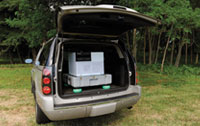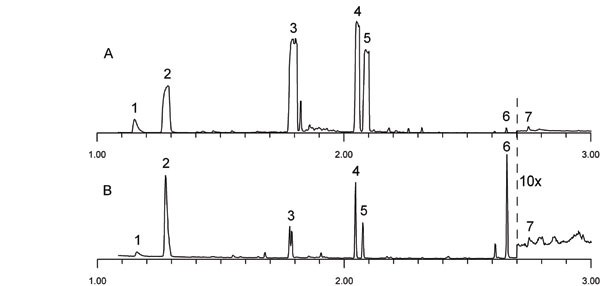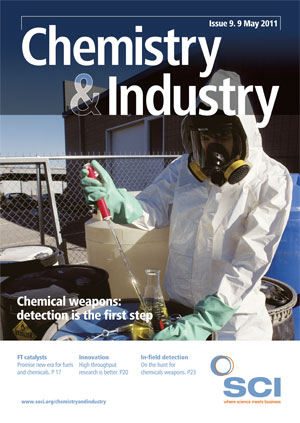As terrorists begin to use more novel chemical and biological agents, the instrumentation to discover these compounds continues to adapt. Such instrumentation is valuable not only for detecting chemicals deployed in the field, but also for ensuring that signatory countries abide by the rules set out in the Geneva Protocol. Despite the prohibition of chemical warfare agents by the 1925 Geneva Protocol1 and, subsequently, the Chemical Weapons Convention in 1997,2 these agents remain a threat to the modern military and the ability to detect them is critical importance.
Indeed, this importance of advanced technology in modern warfare is highlighted by the UK government announcement in December 2010 of a Green Paper beginning a formal consultation on equipment, support and technology for UK defence and security.3 The consultation, led by the Ministry of Defence and the Home Office, will cover a range of issues including national security, working with other countries, exports, SMEs and cyber security – the first time these issues have been considered together from both defence and security perspectives.
While chemical detection instruments are normally required to measure the level of known chemicals, for example, in assessing the acceptable levels of pesticides in food produce or measuring levels of pollutants in the environment, modern warfare creates a unique scenario requiring not only measurement but also identification of chemicals from an unknown sample – rapidly and often in difficult conditions.

Nerve agents were developed mainly during World War II and act by inhibiting acetylcholinesterase throughout the body, which makes them particularly toxic.4 They are rapidly absorbed through the lungs and eyes and can enter systemic circulation in under a minute.

The commercially available detectors on the market a decade ago were primarily photoionisation detectors (PID), flame ionisation detectors (FID) and Draeger Tubes. These detectors were limited by a number of factors; PIDs were largely limited by the presence of dust or dirt and required frequent cleaning to maintain laboratory standard performance, which proved problematic in the field. Also, humidity hampered detection sensitivity and presence of moisture and oxygen resulted in under-reporting of vapour concentration, and therefore these methods could not be relied on to provide an accurate warning. Draeger tubes were the most advanced detector at this time; however, they too had their limitations.5
Since this time the ability to detect CWAs in both the laboratory and the field has improved vastly. Demand for field devices has increased considerably, and remained high following terrorist attacks and conflict situations, such as ‘9/11’ in the US and the Iraq war military operations. Field analysis typically requires rapid assessment of compounds for two reasons. First, by their very nature CWAs are harmful and volatile organic compounds (VOCs); for example, phosgene or cyanogene chloride cause immediate danger. Secondly, to prevent the reporting of a false positive or negative result, multiple tests need to be carried out to ensure accuracy.6
Gas chromatography-mass spectrometry (GC/ MS) has long been the method of choice for chemical warfare agent detection as GC columns can analyse a wide range of samples and MS can provide highly accurate identification of unknown analytes. However, due to the complexity of requiring a vacuum in the MS system and the size of the GC system, its application in the field has been limited.
Transportable GC/MS can provide responders with the fast and accurate identification of highly toxic chemicals based on National Institute of Standards and Technology (NIST) standard mass spectral libraries, with instruments of the same quality as those in laboratory settings. Those responding to an incident suspected to involve toxic chemicals will choose analytical sampling means that fit the situation. This may involve the direct analysis of a liquid or extract, or the sampling of vapours known or suspected in air. Direct sampling, solid phase microextraction (SPME), or thermal desorption of vapours sampled onto sorbent tubes can quickly introduce samples to the GC/MS instrumentation.
Instrumentation should be sufficiently versatile so that responders have the necessary options for making a rapid determination of the hazard. If a fullcapability GC/MS system must be used in the field, first responders should also have the means to move samples a short distance to the instrumentation so that the GC/MS can service a reasonable area and be positioned without becoming contaminated.
Suitability in the field
GC/MS systems suitable for CW detection in the field include the Griffin 450 (ICx Technologies) – a mobile GC/MS system in which the components have been mounted with wire rope isolators to provide resistance against shock and vibration.7 The E²M (Bruker Daltonics) is another mobile GC/ MS system that has demonstrated suitability in the field. This is supported by software tools that feature automated data evaluation based on the NIST spectral library, in addition to other libraries.8
Agilent Technologies’ 5975T LTM GC MSD is a transportable GC-MS system that delivers laboratoryquality analysis. It can provide responders with the fast and accurate identification of highly toxic chemicals based on standard mass spectral libraries with instruments of the same quality as those in laboratory settings. It includes the use of a proprietary Low Thermal Mass GC Technology (LTM) resistively-heated column module in place of the typical air bath oven, to reduce size and enhance transportability. LTM technology also allows for faster GC analysis and higher sample throughput. By providing substantially faster temperature ramp rates, LTM technology shortens GC cycle times, and makes it easier to deal with the varied and sometimes difficult analytical challenges faced in the field.
Power consumption is only half that of a comparable benchtop GC/MS system, the footprint is one-third smaller and weight is reduced by 35%, meaning that it requires less energy to run, takes up less space in the mobile laboratory, and is more transportable in the field. Vacuum-keeping technology keeps the system in a vacuum state even after the system is turned off. This allows the instrument to configure in less time, saving around an hour compared with conventional systems.

A recent field trial of Agilent’s 5975T LTM GC/ MSD system demonstrated its effectiveness for onsite detection of CWAs.9 Samples were provided via a piece of carpet contaminated with a dilute solution of various CWA compounds in methylene chloride:
- O-isopropyl methylphosphonofluoridate (GB, or sarin)
- O-pinacolyl methylphosphonofluoridate (GD, or soman)
- bis(2-chloroethyl) sulphide (HD, or sulphur mustard)
- cyclohexyl methylphosphonofluoridate (GF)
- O-ethyl S-(2-diisopropylaminoethyl) methylphosphonothiolate (VX)
From the sample of contaminated carpet at room temperature, four of the CWA agents were detected (GB, GD, HD, GF), and once the sampling temperature for the contaminated carpet was increased to 110°C, VX was made sufficiently volatile to be sampled, and the same four G and H agents were observed along with VX. In addition, separations were completed in less than three minutes with rapid GC column temperature programming and high H2 carrier gas linear velocity. The liquid injection (about 10ng for each CWA) analysis detected all of the CWA agents. Figure 1 shows the resulting chromatograms.
The instrument also includes a dual selected ion monitoring (SIM)/scan mode that can be very useful for monitoring the presence of specific compounds of concern at trace levels while maintaining the ability to broadly detect other compounds of potential interest. Otherwise, the use of SIM alone for target compounds can leave the analyst blind to the presence of other, perhaps unanticipated, compounds.
Demonstration of the use of dual SIM/scan mode on dilute vapours of the series of alkyl phosphates was made using ions 110 and 99 with a scan range of 50-350 atomic mass units. Dwell times were set at 100ms for the two ions, and this resulted in a scan rate of 4.53 scans/s; sufficient to provide four scans over the narrowest peak of interest. The SIM/scan mode allows simultaneous monitoring of specific ions of concern at low levels while maintaining a general awareness of other analytes present.
Huge leap forward
Improvements in the standard of transportable instrumentation for the detection of chemical warfare agents have been a large focus of research and innovation due to their necessity in protecting the general public, first responder personnel and deployed military forces. Over the last decade, the technology has taken a huge leap forward. The development of methods to reduce power consumption and the size of the GC/MS system has played a valuable role in determining current transportable GC/MS technology. The challenge is to achieve this portability without compromising the quality of the analysis in the field.
As terrorists begin to use more novel chemical and biologic agents, the instrumentation designed to discover these compounds must continue to adapt. Innovation will constantly be required in this field in order to ensure the continued safety of responder personnel and the public.
Robert V. Mustacich is a research scientist at Agilent Technologies, Santa Clara, California, US.
Acknowledgements: Thanks to Phil Smith and Nicholas Martin of the Uniformed Services University of the Health Sciences and Carmela Jackson Lepage of the Defense Research and Development Canada-Suffield who collected the experimental data with chemical weapon agents. Additionally, Phil Smith and Nicholas Martin collaborated on measurements with simulant materials using a variety of techniques.
References
1. Protocol for the prohibition of the use in war of asphyxiating, poisonous or other gases, and of bacteriological methods of warfare, Signed at Geneva: 17 June 1925. http://www.un.org/disarmament/WMD/ Bio/pdf/Status_Protocol.pdf
2. The Organisation for the Prohibition of Chemical Weapons. http://www.opcw.org/about-opcw/
3. UK Ministry of Defence Press Release. 208/2010 - Government engages with industry on defence and security. http://www.mod.uk/DefenceInternet/DefenceNews/ DefencePolicyAndBusiness/Gover nmentEngagesWithIndustryOnDefenceAndSecurity.htm.
4. Federation of American Scientists; http://www.fas.org/programs/bio/chemweapons/ cwagents.html.
5. Longworth, T. L., et al. Testing of commercially available detectors against chemical warfare agents: Summary report. Soldier and Biological Chemical Command, AMSSB-REN, Aberdeen Proving Ground, MD 21010-5424. http://www.chem-bio.com/resource/1999/dp_detectors_ summary.pdf.
6. Eckenrode, B. A., J. Am. Soc. Mass Spectrom., 2001, 12, 683.
7. The Griffin 450 Mobile GC/MS with Air Sampling & Thermal Desorption. http://www.icxt.com/products/icxdetection/ chemical/griffin-450/
8. The E²M Enhanced Environmental Mass Spectrometer. http://www.bdal.com/products/mobile-detection/ chemical-detection/e2m.html
9. Detection of chemical warfare agents by transportable GC/MS. Agilent Technologies. Application note. http://www.chem.agilent.com/en-US/Search/ Library/_layouts/Agilent/PublicationSummary. aspx?whid=646948&liid=2932





